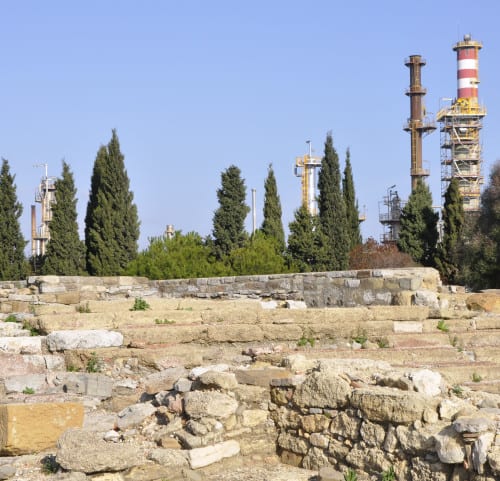IT’S not a question Franco gave much thought to when he encouraged Cepsa to build an ugly oil refinery on top of one of Spain’s most important Roman archaeological sites: Carteia, a surreal juxtaposition of doric columns and petrochemical chimneys.
Like Reg the Anarchist, John Cleese’s character in Monty Python’s Life of Brian who didn’t rate the Romans, Franco didn’t care about Carteia, even though it became the first Latin colony outside Italy in 171BC, making it one of the most privileged cities within the Roman Empire.
Carteia, overlooking the Bay of Gibraltar/Algeciras (depending on your political viewpoint), was the Sotogrande of its day, with luxury villas, a fish-salting factory and a thermal spa.
Think hot and cold plunge pools, a gymnasium, library and toilets where people literally ‘got down to business’ while seated on the pot!
It’s an ancient ruin now, of course. But General Franco and the general public ruined it some more.
A lot of what hasn’t been expropriated for mantelpieces and rockeries is buried beneath a landscape of pollution-belching chimneys.
Cepsa is righting Franco’s wrongs with a costly radar survey to scope out the remains of the 6,000-seater theatre, and the artefact-nicking has stopped. What’s left to see is still pretty amazing and open to visitors, free of charge.
Although you need a bit of imagination and, on days when the Levante’s blowing, a clothes peg for your nose to block out the stench of sulphurous gases.
Carteia became a protected site in 1968 – too late to save the Roman necropolis buried beneath the petro-chemical plant which opened the year before. But archaeological digs have uncovered the columns of temples, the courtyards of villas, mosaics, rings, pendants, hairpins, combs, ceramic pottery and gold coins. Carteia had its own mint!
New treasures are constantly being discovered, especially when it rains, as only 7% of the site has been excavated.
The Romans knew exactly what the Carteia could give to them:
- Control of the strategic Mediterranean gateway
- Wood for boat-building and lead, iron and copper for weapons
- Cereals and fish to feed hungry armies on the march
- Silver to embellish Pompey’s banqueting table back home
- Murex sea snails which secrete a no-fade purple dye that was all the rage in Rome
Over the next 580 years, Carteia grew to 25,000 citizens on the back of booming pottery and tuna fishing industries.
The Visigoths came after and built a church on top of the gym and the Moors had greater ambitions on other cities. No one much bothered with Carteia again until WW2 when two bunkers were built there – one of them recently re-opened by Cepsa as Andalucía’s first bunker museum.
Today, you can’t visit the site without a guide. You can’t enter with large bags or rucksacks. You can’t eat or drink on site or touch anything. And you can’t take photographs for publication without prior permission.
It smacks of dictatorship but not, in this case, Franco’s. To him, Carteia was just a pile of old stones.
Click here to read more News from The Olive Press.








This article seems a little pamphlet.
Contempt for the archaeological heritage, was a problem of mentality of people, that has begun to correct a few years ago, and it still exists. Franco was not responsible for this problem,that in my opinion continues.